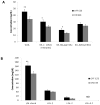Effect of ezetimibe on low- and high-density lipoprotein subclasses in sitosterolemia
- PMID: 28340366
- PMCID: PMC5419426
- DOI: 10.1016/j.atherosclerosis.2017.03.015
Effect of ezetimibe on low- and high-density lipoprotein subclasses in sitosterolemia
Abstract
Background and aims: Sitosterolemia displays high plasma total sterols [high plant sterols (PS) + normal to high total cholesterol (TC)] with normal to moderately elevated low-density lipoprotein (LDL) levels. High LDL, intermediate-density lipoprotein (IDL) and very low-density lipoprotein (VLDL) particles, low high-density lipoprotein (HDL), and increased non-HDL and the ratios of TC and triglycerides (TG) to HDL can increase the risk for atherosclerosis. Ezetimibe (EZE) can reduce plasma PS and TC levels in sitosterolemia, but its effect on lipoprotein subclasses has not been previously reported.
Methods: Sitosterolemia patients (n = 8) were taken off EZE for 14 weeks (OFF EZE) and placed on EZE (10 mg/d) for 14 weeks (ON EZE). Serum lipids were measured enzymatically and lipoprotein subclasses were assessed by polyacrylamide gel electrophoresis.
Results: EZE reduced (p < 0.05) total sterols (-12.5 ± 4.1%) and LDL-sterol (-22.7 ± 5.7%) and its sterol mass of large VLDL (-24.4 ± 4.5%), VLDL remnants (-21.1 ± 7.9%) and large IDL (-22.4 ± 7.2%) compared to OFF EZE. EZE did not affect large LDL subclasses or mean LDL particle size (273.8 ± 0.6 vs. 274.6 ± 0.3 Å). EZE increased HDL-sterol (25.5 ± 8.0%, p = 0.008) including intermediate (34 ± 14%, p = 0.02) and large (33 ± 16%, p = 0.06) HDL. EZE reduced non-HDL-sterol (-21.8± 5.0%), total sterols/HDL (-28.2 ± 5.5%) and TG/HDL (-27.4 ± 6.5%, all p < 0.01).
Conclusions: EZE improves VLDL and HDL subfraction distribution, thereby reducing the atherogenic lipid profile, thus providing potential clinical benefit in sitosterolemia beyond TC and PS reduction.
Keywords: Ezetimibe; HDL subclasses; LDL cholesterol; LDL subclasses; Mean LDL particle size; Non-HDL cholesterol; Sitosterolemia; Sterols.
Copyright © 2017 Elsevier B.V. All rights reserved.
Conflict of interest statement
The authors declared they do not have anything to disclose regarding conflict of interest with respect to this manuscript.
Figures


Comment in
-
Antiatherogenic potential of ezetimibe in sitosterolemia: Beyond plant sterols lowering.Atherosclerosis. 2017 May;260:94-96. doi: 10.1016/j.atherosclerosis.2017.03.034. Epub 2017 Mar 25. Atherosclerosis. 2017. PMID: 28365445 No abstract available.
References
-
- Salen G, et al. Sitosterolemia. J Lipid Res. 1992;33(7):945–55. - PubMed
-
- Mymin D, et al. Image in cardiovascular medicine. Aortic xanthomatosis with coronary ostial occlusion in a child homozygous for a nonsense mutation in ABCG8. Circulation. 2003;107(5):791. - PubMed
-
- Kwiterovich PO, Jr, et al. Hyperapobetalipoproteinaemia in two families with xanthomas and phytosterolaemia. Lancet. 1981;1(8218):466–9. - PubMed
-
- Wang Z, et al. Specific macrothrombocytopenia/hemolytic anemia associated with sitosterolemia. Am J Hematol. 2014;89(3):320–4. - PubMed
-
- Othman RA, Myrie SB, Jones PJ. Non-cholesterol sterols and cholesterol metabolism in sitosterolemia. Atherosclerosis. 2013;231(2):291–9. - PubMed
Publication types
MeSH terms
Substances
Supplementary concepts
Grants and funding
LinkOut - more resources
Full Text Sources
Other Literature Sources
Medical
Miscellaneous

